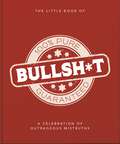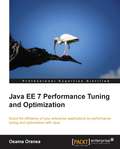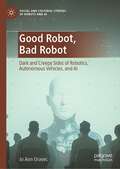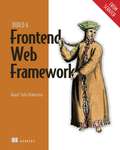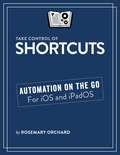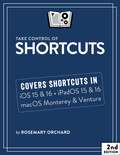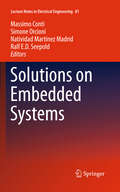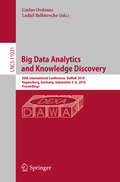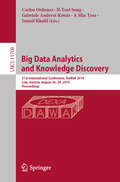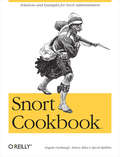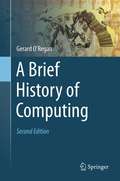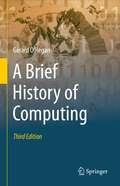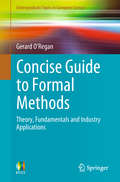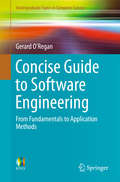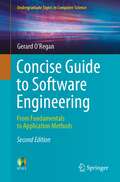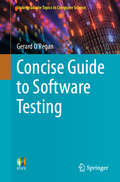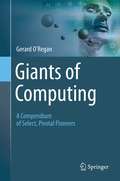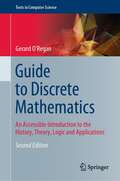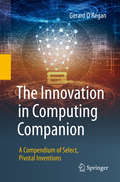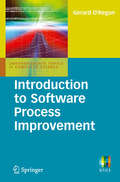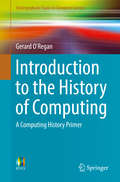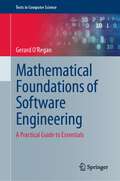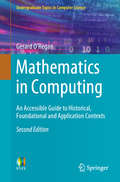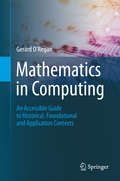- Table View
- List View
The Little Book of Bullshit: A Load of Lies too Good to be True (The\little Book Of... Ser.)
by Orange Hippo!The Golden Age of Bullshit.Welcome to the golden age of bullshit, a wiki-wild world knee deep in half-truths and alternative facts, spin and bias, influence and insincerity, little white lies and tall tales, falsehoods and propaganda, and all sorts of other baloney designed to disguise fact from fiction. We live in a post truth, fake news, world where nothing is quite as it seems and everything you read should be seen before believed. But isn't.From Brexit buses to Donald Trump, the University of Google to misleading advertising claims, and everything in-between, the bullshit keeps getting bigger and stronger and the lies are turning truer every day. It's time to call bullshit on bullshit!The Little Book of Bullshit is the ideal antidote everybody needs to fight the influx of excessive lying and cheating and defrauding that has come to define the 21st century, a tiny tome stuffed with delightfully witty snack-sized nuggets of facts and stats and quotes and boasts all related to the ever-expanding world of bullshit."The first rule of bullshit is that it must be believable." Nassim Nicholas Taleb"I'm almost finished..." All of us, at some point in our lives
Java EE 7 Performance Tuning and Optimization
by Osama OransaThe book adopts a step-by-step approach, starting from building the basics and adding to it gradually by using different tools and examples. The book sequence is easy to follow and all topics are fully illustrated showing you how to make good use of different performance diagnostic tools. If you are an experienced Java developer, architect, team leader, consultant, support engineer, or anyone else who needs performance tuning in your Java applications, and in particular, Java enterprise applications, this book is for you. No prior experience of performance tuning is required.
Good Robot, Bad Robot: Dark and Creepy Sides of Robotics, Autonomous Vehicles, and AI (Social and Cultural Studies of Robots and AI)
by Jo Ann OravecThis book explores how robotics and artificial intelligence (AI) can enhance human lives but also have unsettling “dark sides.” It examines expanding forms of negativity and anxiety about robots, AI, and autonomous vehicles as our human environments are reengineered for intelligent military and security systems and for optimal workplace and domestic operations. It focuses on the impacts of initiatives to make robot interactions more humanlike and less creepy (as with domestic and sex robots). It analyzes the emerging resistances against these entities in the wake of omnipresent AI applications (such as “killer robots” and ubiquitous surveillance). It unpacks efforts by developers to have ethical and social influences on robotics and AI, and confronts the AI hype that is designed to shield the entities from criticism. The book draws from science fiction, dramaturgical, ethical, and legal literatures as well as current research agendas of corporations. Engineers, implementers, and researchers have often encountered users' fears and aggressive actions against intelligent entities, especially in the wake of deaths of humans by robots and autonomous vehicles. The book is an invaluable resource for developers and researchers in the field, as well as curious readers who want to play proactive roles in shaping future technologies.
Build a Frontend Web Framework (From Scratch)
by Ángel Sola OrbaicetaLearn how a frontend web framework works by coding your own!Web developers use frontend frameworks every day—but do you know how these essential parts of your stack really work? Build a Frontend Web Framework (From Scratch) reveals the inner workings of web frameworks by helping you create your very own. In Build a Frontend Web Framework (From Scratch), you&’ll learn the secrets behind frameworks like React, Vue, and Angular, including: Create HTML documents programmatically Define the view with virtual DOM Update the HTML efficiently with reconciliation algorithms Create two-way communication mechanisms between components in a hierarchy Whatever your experience level, you&’ll be able to start building your framework with this guide. All you need is some core skills in HTML, CSS, and JavaScript. And once you&’ve learned how frameworks function, you&’ll be able to work with them more efficiently, troubleshoot bugs more effectively, and even customize them for your specific needs! About the technology You use frontend frameworks every day, but do you really know what&’s going on behind the API? Building your own framework is a great way to learn how they interact with the DOM, generate page views, route data between components, and communicate with the underlying operating system. With this interesting and entertaining book, you&’ll build your own web framework step-by-step in JavaScript, ready to share with the world as an NPM package! About the book Build a Frontend Web Framework (From Scratch) guides you through a simple component-based frontend framework that borrows from React, Svelte, Angular, and other familiar tools. You&’ll learn how a modern framework operates by adding features like component state and lifecycle management, a virtual DOM, and reconciliation algorithms to update the HTML efficiently. You&’ll appreciate how each critical concept is broken down into easy-to-digest chunks and explained with engaging graphics. What's inside Create HTML documents programmatically Define the view with the virtual DOM Implement a component lifecycle scheduler About the reader For web developers familiar with JavaScript and Node. About the author Angel Sola Orbaiceta has worked in the software industry for over a decade, creating software for the cloud, macOS, and Windows desktop applications. Table of Contents PART 1 1 Are frontend frameworks magic to you? 2 Vanilla JavaScript—like in the old days PART 2 3 Rendering and the virtual DOM 4 Mounting and destroying the virtual DOM 5 State management and the application&’s lifecycle 6 Publishing and using your framework&’s first version 7 The reconciliation algorithm: Diffing virtual trees 8 The reconciliation algorithm: Patching the DOM PART 3 9 Stateful components 10 Component methods 11 Subcomponents: Communication via props and events 12 Keyed lists 13 The component lifecycle hooks and the scheduler 14 Testing asynchronous components Appendix
Take Control of Shortcuts
by Rosemary OrchardAutomation is no longer just for advanced Mac and PC users! Apple's Shortcuts app lets anyone with an iPhone or iPad automate day-to-day tasks, from the simple to the complex. This book is a complete introduction to Shortcuts, which covers every aspect of building, installing, debugging, running, syncing, and sharing shortcuts. It also includes step-by-step recipes for creating numerous useful shortcuts yourself.
Take Control of Shortcuts
by Rosemary OrchardAutomation is no longer just for advanced computer users! Apple's Shortcuts app lets anyone with an iPhone, iPad, or Mac automate day-to-day tasks, from the simple to the complex. This book is a complete introduction to Shortcuts, covering every aspect of building, installing, debugging, running, syncing, and sharing shortcuts. It also includes step-by-step recipes for creating numerous useful shortcuts yourself.
Solutions on Embedded Systems
by Simone Orcioni Natividad Martínez Madrid Massimo Conti Ralf E.D. SeepoldEmbedded systems have an increasing importance in our everyday lives. The growing complexity of embedded systems and the emerging trend to interconnections between them lead to new challenges. Intelligent solutions are necessary to overcome these challenges and to provide reliable and secure systems to the customer under a strict time and financial budget. Solutions on Embedded Systems documents results of several innovative approaches that provide intelligent solutions in embedded systems. The objective is to present mature approaches, to provide detailed information on the implementation and to discuss the results obtained.
Big Data Analytics and Knowledge Discovery: 20th International Conference, DaWaK 2018, Regensburg, Germany, September 3–6, 2018, Proceedings (Lecture Notes in Computer Science #11031)
by Carlos Ordonez Ladjel BellatrecheThis book constitutes the refereed proceedings of the 20th International Conference on Big Data Analytics and Knowledge Discovery, DaWaK 2018, held in Regensburg, Germany, in September 2018.The 13 revised full papers and 17 short papers presented were carefully reviewed and selected from 76 submissions. The papers are organized in the following topical sections: Graph analytics; case studies; classification and clustering; pre-processing; sequences; cloud and database systems; and data mining.
Big Data Analytics and Knowledge Discovery: 21st International Conference, DaWaK 2019, Linz, Austria, August 26–29, 2019, Proceedings (Lecture Notes in Computer Science #11708)
by Carlos Ordonez Il-Yeol Song Gabriele Anderst-Kotsis A Min Tjoa Ismail KhalilThis book constitutes the refereed proceedings of the 21st International Conference on Big Data Analytics and Knowledge Discovery, DaWaK 2019, held in Linz, Austria, in September 2019. The 12 full papers and 10 short papers presented were carefully reviewed and selected from 61 submissions. The papers are organized in the following topical sections: Applications; patterns; RDF and streams; big data systems; graphs and machine learning; databases.
Snort Cookbook
by Angela Orebaugh Simon Biles Jacob BabbinIf you are a network administrator, you're under a lot of pressure to ensure that mission-critical systems are completely safe from malicious code, buffer overflows, stealth port scans, SMB probes, OS fingerprinting attempts, CGI attacks, and other network intruders. Designing a reliable way to detect intruders before they get in is an essential--but often overwhelming--challenge. Snort, the defacto open source standard of intrusion detection tools, is capable of performing real-time traffic analysis and packet logging on IP network. It can perform protocol analysis, content searching, and matching. Snort can save countless headaches; the new Snort Cookbook will save countless hours of sifting through dubious online advice or wordy tutorials in order to leverage the full power of SNORT. Each recipe in the popular and practical problem-solution-discussion O'Reilly cookbook format contains a clear and thorough description of the problem, a concise but complete discussion of a solution, and real-world examples that illustrate that solution. The Snort Cookbook covers important issues that sys admins and security pros will us everyday, such as: installation optimization logging alerting rules and signatures detecting viruses countermeasures detecting common attacks administration honeypots log analysis But the Snort Cookbook offers far more than quick cut-and-paste solutions to frustrating security issues. Those who learn best in the trenches--and don't have the hours to spare to pore over tutorials or troll online for best-practice snippets of advice--will find that the solutions offered in this ultimate Snort sourcebook not only solve immediate problems quickly, but also showcase the best tips and tricks they need to master be security gurus--and still have a life.
A Brief History of Computing
by Gerard O'ReganThis lively and fascinating text traces the key developments in computation - from 3000 B.C. to the present day - in an easy-to-follow and concise manner. Topics and features: ideal for self-study, offering many pedagogical features such as chapter-opening key topics, chapter introductions and summaries, exercises, and a glossary; presents detailed information on major figures in computing, such as Boole, Babbage, Shannon, Turing, Zuse and Von Neumann; reviews the history of software engineering and of programming languages, including syntax and semantics; discusses the progress of artificial intelligence, with extension to such key disciplines as philosophy, psychology, linguistics, neural networks and cybernetics; examines the impact on society of the introduction of the personal computer, the World Wide Web, and the development of mobile phone technology; follows the evolution of a number of major technology companies, including IBM, Microsoft and Apple.
A Brief History of Computing
by Gerard O'ReganThis lively and fascinating text traces the key developments in computation – from 3000 B.C. to the present day – in an easy-to-follow and concise manner. Topics and features: ideal for self-study, offering many pedagogical features such as chapter-opening key topics, chapter introductions and summaries, exercises, and a glossary; presents detailed information on major figures in computing, such as Boole, Babbage, Shannon, Turing, Zuse and Von Neumann; discusses the earliest computers developed in the United States, Germany and Britain; discusses the development of the IBM 360 family of computers and its importance; discusses the invention of the transistor and integrated circuit; discusses the birth of the software industry and the evolution of human-computer interaction; reviews the history of programming languages, operating systems and software engineering; discusses the progress of artificial intelligence; discusses the invention of the microprocessor and the development of home and personal computers; examines the impact on society of the introduction of the personal computer, the World Wide Web, and the development of mobile phone technology; discusses smart phones and social media and the challenge of fake news; reviews a miscellany of innovations in the computing field such as cloud computing, the Internet of Things, and Quantum Computing; discusses legal aspects of computing and the professional responsibilities of computer professionals.
Concise Guide to Formal Methods
by Gerard O'ReganThis invaluable textbook/reference provides an easy-to-read guide to the fundamentals of formal methods, highlighting the rich applications of formal methods across a diverse range of areas of computing.Topics and features: introduces the key concepts in software engineering, software reliability and dependability, formal methods, and discrete mathematics; presents a short history of logic, from Aristotle’s syllogistic logic and the logic of the Stoics, through Boole’s symbolic logic, to Frege’s work on predicate logic; covers propositional and predicate logic, as well as more advanced topics such as fuzzy logic, temporal logic, intuitionistic logic, undefined values, and the applications of logic to AI; examines the Z specification language, the Vienna Development Method (VDM) and Irish School of VDM, and the unified modelling language (UML); discusses Dijkstra’s calculus of weakest preconditions, Hoare’s axiomatic semantics of programming languages, and the classical approach of Parnas and his tabular expressions; provides coverage of automata theory, probability and statistics, model checking, and the nature of proof and theorem proving; reviews a selection of tools available to support the formal methodist, and considers the transfer of formal methods to industry; includes review questions and highlights key topics in every chapter, and supplies a helpful glossary at the end of the book.This stimulating guide provides a broad and accessible overview of formal methods for students of computer science and mathematics curious as to how formal methods are applied to the field of computing.
Concise Guide to Software Engineering
by Gerard O'ReganThis essential textbook presents a concise introduction to the fundamental principles of software engineering, together with practical guidance on how to apply the theory in a real-world, industrial environment. The wide-ranging coverage encompasses all areas of software design, management, and quality.Topics and features: presents a broad overview of software engineering, including software lifecycles and phases in software development, and project management for software engineering; examines the areas of requirements engineering, software configuration management, software inspections, software testing, software quality assurance, and process quality; covers topics on software metrics and problem solving, software reliability and dependability, and software design and development, including Agile approaches; explains formal methods, a set of mathematical techniques to specify and derive a program from its specification, introducing the Z specification language; discusses software process improvement, describing the CMMI model, and introduces UML, a visual modelling language for software systems; reviews a range of tools to support various activities in software engineering, and offers advice on the selection and management of a software supplier; describes such innovations in the field of software as distributed systems, service-oriented architecture, software as a service, cloud computing, and embedded systems; includes key learning topics, summaries and review questions in each chapter, together with a useful glossary.This practical and easy-to-follow textbook/reference is ideal for computer science students seeking to learn how to build high quality and reliable software on time and on budget. The text also serves as a self-study primer for software engineers, quality professionals, and software managers.
Concise Guide to Software Engineering: From Fundamentals to Application Methods (Undergraduate Topics in Computer Science)
by Gerard O'ReganThis textbook presents a concise introduction to the fundamental principles of software engineering, together with practical guidance on how to apply the theory in a real-world, industrial environment. The wide-ranging coverage encompasses all areas of software design, management, and quality.Topics and features: presents a broad overview of software engineering, including software lifecycles and phases in software development, and project management for software engineering; examines the areas of requirements engineering, software configuration management, software inspections, software testing, software quality assurance, and process quality; covers topics on software metrics and problem solving, software reliability and dependability, and software design and development, including Agile approaches; explains formal methods, a set of mathematical techniques to specify and derive a program from its specification, introducing the Z specification language; discusses software process improvement, describing the CMMI model, and introduces UML, a visual modelling language for software systems; reviews a range of tools to support various activities in software engineering, and offers advice on the selection and management of a software supplier; describes such innovations in the field of software as distributed systems, service-oriented architecture, software as a service, cloud computing, and embedded systems; includes key learning topics, summaries and review questions in each chapter, together with a useful glossary.This practical and easy-to-follow textbook/reference is ideal for computer science students seeking to learn how to build high quality and reliable software on time and on budget. The text also serves as a self-study primer for software engineers, quality professionals, and software managers.
Concise Guide to Software Testing (Undergraduate Topics in Computer Science)
by Gerard O'ReganThis practically-focused textbook provides a concise and accessible introduction to the field of software testing, explaining the fundamental principles and offering guidance on applying the theory in an industrial environment.Topics and features: presents a brief history of software quality and its influential pioneers, as well as a discussion of the various software lifecycles used in software development; describes the fundamentals of testing in traditional software engineering, and the role that static testing plays in building quality into a product; explains the process of software test planning, test analysis and design, and test management; discusses test outsourcing, and test metrics and problem solving; reviews the tools available to support software testing activities, and the benefits of a software process improvement initiative; examines testing in the Agile world, and the verification of safety critical systems; considers the legal and ethical aspects of software testing, and the importance of software configuration management; provides key learning topics and review questions in every chapter, and supplies a helpful glossary at the end of the book.This easy-to-follow guide is an essential resource for undergraduate students of computer science seeking to learn about software testing, and how to build high quality and reliable software on time and on budget. The work will also be of interest to industrialists including software engineers, software testers, quality professionals and software managers, as well as the motivated general reader.
Ethical and Legal Aspects of Computing: A Professional Perspective from Software Engineering (Undergraduate Topics in Computer Science)
by Gerard O'ReganThis textbook presents an overview of the critically important ethical and legal issues that arise in the computing field and provides a professional perspective from software engineering. The author gained exposure to these aspects of computing while working as a software engineer at Motorola in Ireland, where he coordinated the patent programme and worked with several software suppliers. Topics and features: Presents a broad overview of ethics and the lawIncludes key learning topics, summaries, and review questions in each chapter, together with a useful glossaryDiscusses the professional responsibility of computer professionalsExplores ethics in various civilisations and religious traditionsDiscusses ethical software engineering and ethical outsourcingConsiders what is fair and ethical in data scienceDescribes ethical challenges that arise in social media and the AI fieldReviews intellectual property including patents, copyright and trademarks This practical and easy-to-follow textbook/reference is ideal for computer science students seeking to understand legal and ethical aspects of computing. The text also serves as a concise self-study primer for software engineers and software managers.
Giants of Computing: A Compendium of Select, Pivotal Pioneers
by Gerard O’reganIt has been upon the shoulders of giants that the modern world has been forged. This accessible compendium presents an insight into the great minds responsible for the technology which has transformed our lives. Each pioneer is introduced with a brief biography, followed by a concise account of their key contributions to their discipline. The selection covers a broad spread of historical and contemporary figures from theoreticians to entrepreneurs, highlighting the richness of the field of computing. Suitable for the general reader, this concise and easy-to-read reference will be of interest to anyone curious about the inspiring men and women who have shaped the field of computer science.
Guide to Discrete Mathematics: An Accessible Introduction to the History, Theory, Logic and Applications (Texts in Computer Science)
by Gerard O'ReganThis stimulating textbook presents a broad and accessible guide to the fundamentals of discrete mathematics, highlighting how the techniques may be applied to various exciting areas in computing. The text is designed to motivate and inspire the reader, encouraging further study in this important skill. Features: This book provides an introduction to the building blocks of discrete mathematics, including sets, relations and functions; describes the basics of number theory, the techniques of induction and recursion, and the applications of mathematical sequences, series, permutations, and combinations; presents the essentials of algebra; explains the fundamentals of automata theory, matrices, graph theory, cryptography, coding theory, language theory, and the concepts of computability and decidability; reviews the history of logic, discussing propositional and predicate logic, as well as advanced topics such as the nature of theorem proving; examines the field of software engineering, including software reliability and dependability and describes formal methods; investigates probability and statistics and presents an overview of operations research and financial mathematics.
The Innovation in Computing Companion: A Compendium of Select, Pivotal Inventions
by Gerard O’ReganThis encyclopedic reference provides a concise and engaging overview of the groundbreaking inventions and conceptual innovations that have shaped the field of computing, and the technology that runs the modern world. Each alphabetically-ordered entry presents a brief account of a pivotal innovation and the great minds behind it, selected from a wide range of diverse topics.Topics and features:Describes the development of Babbage’s computing machines, Leibniz’s binary arithmetic, Boole’s symbolic logic, and Von Neumann architectureReviews a range of historical analog and digital computers, significant mainframes and minicomputers, and pioneering home and personal computersDiscusses a selection of programming languages and operating systems, along with key concepts in software engineering and commercial computingExamines the invention of the transistor, the integrated circuit, and the microprocessorRelates the history of such developments in personal computing as the mouse, the GUI, Atari video games, and Microsoft OfficeSurveys innovations in communications, covering mobile phones, WiFi, the Internet and World Wide Web, e-commerce, smartphones, social media, and GPSPresents coverage of topics on artificial intelligence, the ATM, digital photography and digital music, robotics, and WikipediaContains self-test quizzes and a helpful glossaryThis enjoyable compendium will appeal to the general reader curious about the intellectual milestones that led to the digital age, as well as to the student of computer science seeking a primer on the history of their field.Dr. Gerard O'Regan is a CMMI software process improvement consultant with research interests including software quality and software process improvement, mathematical approaches to software quality, and the history of computing. He is the author of such Springer titles as World of Computing, Concise Guide to Formal Methods, Concise Guide to Software Engineering, and Guide to Discrete Mathematics.
Introduction to Software Process Improvement
by Gerard O'ReganThis textbook is a systematic guide to the steps in setting up a Capability Maturity Model Integration (CMMI) improvement initiative. Readers will learn the project management practices necessary to deliver high-quality software solutions to the customer on time and on budget. The text also highlights how software process improvement can achieve specific business goals to provide a tangible return on investment. Topics and features: supplies review questions, summaries and key topics for each chapter, as well as a glossary of acronyms; describes the CMMI model thoroughly, detailing the five maturity levels; provides a broad overview of software engineering; reviews the activities and teams required to set up a CMMI improvement initiative; examines in detail the implementation of CMMI in a typical organization at each of the maturity levels; investigates the various tools that support organizations in improving their software engineering maturity; discusses the SCAMPI appraisal methodology.
Introduction to the History of Computing
by Gerard O'ReganTracing the story of computing from Babyloniancounting boards to smartphones, this inspiring textbook provides a conciseoverview of the key events in the history of computing, together withdiscussion exercises to stimulate deeper investigation into this fascinatingarea. Features: provides chapter introductions, summaries, key topics, and reviewquestions; includes an introduction to analogue and digital computers, and to thefoundations of computing; examines the contributions of ancient civilisationsto the field of computing; covers the first digital computers, and the earliestcommercial computers, mainframes and minicomputers; describes the earlydevelopment of the integrated circuit and the microprocessor; reviews theemergence of home computers; discusses the creation of the Internet, theinvention of the smartphone, and the rise of social media; presents a shorthistory of telecommunications, programming languages, operating systems,software engineering, artificial intelligence, and databases.
Mathematical Foundations of Software Engineering: A Practical Guide to Essentials (Texts in Computer Science)
by Gerard O'ReganThis textbook presents an introduction to the mathematical foundations of software engineering. It presents the rich applications of mathematics in areas such as error-correcting codes, cryptography, the safety and security critical fields, the banking and insurance fields, as well as traditional engineering applications. Topics and features: Addresses core mathematics for critical thinking and problem solving Discusses propositional and predicate logic and various proof techniques to demonstrate the correctness of a logical argument. Examines number theory and its applications to cryptography Considers the underlying mathematics of error-correcting codes Discusses graph theory and its applications to modelling networks Reviews tools to support software engineering mathematics, including automated and interactive theorem provers and model checking Discusses financial software engineering, including simple and compound interest, probability and statistics, and operations research Discusses software reliability and dependability and explains formal methods used to derive a program from its specification Discusses calculus, matrices, vectors, complex numbers, and quaternions, as well as applications to graphics and robotics Includes key learning topics, summaries, and review questions in each chapter, together with a useful glossary This practical and easy-to-follow textbook/reference is ideal for computer science students seeking to learn how mathematics can assist them in building high-quality and reliable software on time and on budget. The text also serves as an excellent self-study primer for software engineers, quality professionals, and software managers.
Mathematics in Computing: An Accessible Guide to Historical, Foundational and Application Contexts (Undergraduate Topics in Computer Science)
by Gerard O’ReganThis illuminating textbook provides a concise review of the core concepts in mathematics essential to computer scientists. Emphasis is placed on the practical computing applications enabled by seemingly abstract mathematical ideas, presented within their historical context. The text spans a broad selection of key topics, ranging from the use of finite field theory to correct code and the role of number theory in cryptography, to the value of graph theory when modelling networks and the importance of formal methods for safety critical systems.This fully updated new edition has been expanded with a more comprehensive treatment of algorithms, logic, automata theory, model checking, software reliability and dependability, algebra, sequences and series, and mathematical induction.Topics and features: includes numerous pedagogical features, such as chapter-opening key topics, chapter introductions and summaries, review questions, and a glossary; describes the historical contributions of such prominent figures as Leibniz, Babbage, Boole, and von Neumann; introduces the fundamental mathematical concepts of sets, relations and functions, along with the basics of number theory, algebra, algorithms, and matrices; explores arithmetic and geometric sequences and series, mathematical induction and recursion, graph theory, computability and decidability, and automata theory; reviews the core issues of coding theory, language theory, software engineering, and software reliability, as well as formal methods and model checking; covers key topics on logic, from ancient Greek contributions to modern applications in AI, and discusses the nature of mathematical proof and theorem proving; presents a short introduction to probability and statistics, complex numbers and quaternions, and calculus.This engaging and easy-to-understand book will appeal to students of computer science wishing for an overview of the mathematics used in computing, and to mathematicians curious about how their subject is applied in the field of computer science. The book will also capture the interest of the motivated general reader.
Mathematics in Computing
by Gerard O’reganThis clearly written and enlightening textbook provides a concise, introductory guide to the key mathematical concepts and techniques used by computer scientists. Topics and features: ideal for self-study, offering many pedagogical features such as chapter-opening key topics, chapter introductions and summaries, review questions, and a glossary; places our current state of knowledge within the context of the contributions made by early civilizations, such as the ancient Babylonians, Egyptians and Greeks; examines the building blocks of mathematics, including sets, relations and functions; presents an introduction to logic, formal methods and software engineering; explains the fundamentals of number theory, and its application in cryptography; describes the basics of coding theory, language theory, and graph theory; discusses the concept of computability and decideability; includes concise coverage of calculus, probability and statistics, matrices, complex numbers and quaternions.
